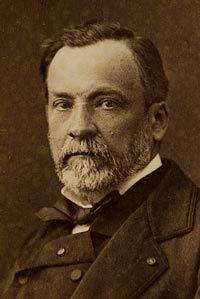
| Born: Dec 27, 1822 at Dole, Jura, Franche-Comté, France |
| Died: Sep 28, 1895 (at age 72) at Marnes-la-Coquette, Hauts-de-Seine, France |
| Nationality: French |
Louis Pasteur helped resolve the mysteries of several deadly diseases like chicken cholera, anthrax, rabies and silkworm diseases. He also contributed to the development of the very first vaccines. Louis Pasteur’s research and work gave birth to several branches of science and he was responsible for many of the theoretical concepts and applications that are still used today.
Childhood, Career and Personal Life
On December 27, 1822, Louis Pasteur was born in the town of Dole, situated in Eastern France. His father was a tanner. In 1840, Louis earned his Bachelor of Arts degree and in 1842, he earned a Bachelor of Science degree from the Ecole Normale. In the year 1848, he took a job teaching physics at Dijon Lycee.
Before long, Pasteur became the professor of chemistry at the University of Strasbourg. This is where he met and married Marie Laurent. The couple had five kids out of which only two survived into adulthood. Typhoid was the reason for his children’s death. Pasteur’s personal loss led him study the cause for incurable diseases.
Tartaric Acid and Pasteurization
When he was 26 years old, Pasteur resolved a subject that had been baffling the chemists of that time. He discovered that when light was passed through a dissolved solution of tartaric acid (found in wine-dregs), it created an unusual effect. He demonstrated that this was because the tartaric acid is actually not just one acid but a combination of different acids. This particular find amazed the scientists and established Louis Pasteur’s reputation.
During Pasteur’s period, the souring of wine and beer caused huge loss of money for wine producers in France. Pasteur, along with other scientists, found that heating up the sugar solutions to high temperatures eliminated an ample amount of the bacteria to avoid spoilage. Then he applied the same concept to other products like milk, cheese, and other foods. This is how he came up with pasteurization. Having the name of the inventor, the entire process of pasteurization is still extensively used throughout the world today.
Vaccine Discovery
Pasteur’s first vaccine discovery was in 1879 with a contagious disease called chicken-cholera. After unexpectedly exposing chickens to the weakened form of a disease, he proved that they became immune to the actual virus. Pasteur continued to extend his “germ theory” to formulate vaccinations for various diseases including anthrax, smallpox and cholera.
In 1882, Pasteur made a decision to emphasize his efforts and research on the subject of rabies disease which was proven to attack the central nervous system. In 1885, he vaccinated Joseph Meister, a nine-year-old boy who had previously been bitten 14 times by a rabid dog. The effective results of Pasteur’s vaccine for rabies brought him instant fame. This set off a worldwide fundraising campaign to construct the Pasteur Institute in Paris, France, which was inaugurated on November 14, 1888.
Pasteur’s Later Life and Death
Pasteur suffered from brain-strokes which started in 1868. He passed away on September 28, 1895, at Saint Cloud. He was buried in Notre Dame Cathedral. Later, his body was placed in a crypt just below the Pasteur Institute, Paris. Many of his techniques are still in use today.